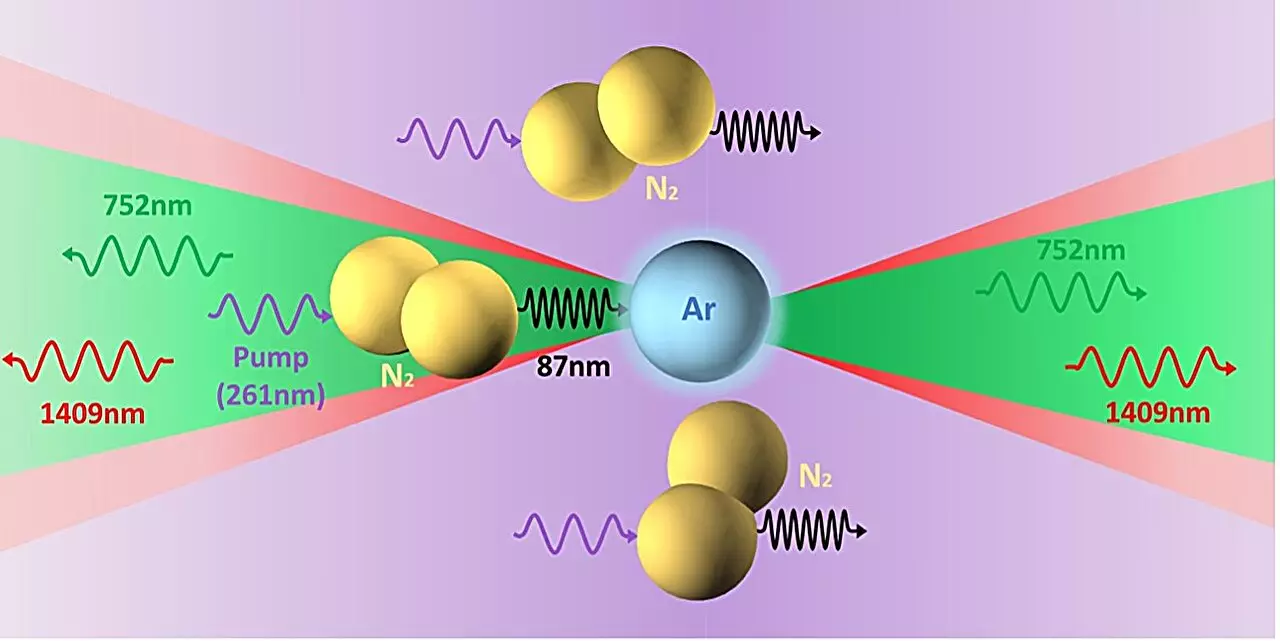The production of light has traditionally relied on optical cavities within lasers, where mirrors enhance and direct light by reflecting it repeatedly. This well-established method is transitioning into uncharted territories as physicists explore the possibility of generating laser-like light in open air without the necessity of these optical cavities. This groundbreaking phenomenon, termed cavity-free lasing, represents a significant leap in laser technology and offers intriguing possibilities for future applications.
Recent investigations conducted by researchers at the University of California, Los Angeles, in collaboration with the Max Born Institute, have shed light on the intricate mechanisms that enable cavity-free lasing in atmospheric conditions. Their findings, published in the esteemed journal Physical Review Letters, focus on a remarkable photon-mediated process that facilitates energy transfer from nitrogen (N2) to argon (Ar). Co-author Chan Joshi elaborates on this common yet complex interaction, noting a discrepancy between observed and predicted ionization rates, prompting them to delve deeper into the phenomenon.
The research team’s initial experiments unveiled a connection between three-photon resonant absorption of ultraviolet light (261 nm) by argon atoms, linking it to phenomena such as cascaded superfluorescence. This is characterized by bidirectional and laser-like emissions that do not rely on traditional cavity structures. The results have implications for how we understand light interaction in atmospheric air, suggesting that even the most ubiquitous gases can facilitate advanced laser properties under specific conditions.
One of the most striking outcomes from this research was the discovery of unique wavelength switching behavior in the cascaded superfluorescence process when air comprised a mere 1% argon. Lead author Zan Nie emphasizes that this curious effect is not just a laboratory curiosity; it may represent a new mechanism through which atmospheric air can achieve lasing capabilities. By mixing argon with other major atmospheric constituents, particularly nitrogen and oxygen, the researchers pinpointed that nitrogen plays a crucial role in the lasing effect, while other gases like helium exhibited no similar results.
This pivotal experimentation not only reinforced the foundational role of nitrogen but also illuminated how intricate the relationships between different gas molecules can be during light emission processes. The research team’s systematic approach in comparing various gas compositions thus provides deeper insight into the fundamental aspects of air lasing.
Digging further into the underlying physical principles, Joshi’s team discovered that nitrogen molecules in an excited electronic state engage in nonlinear three-photon absorption at frequencies slightly shifted from those of argon. This interplay establishes the necessary upper energy states essential for the observed cascaded superfluorescence. The nuances of these interactions suggest a complex landscape where various energy states influence lasing behaviors, revealing layers of quantum mechanics seldom explored in conventional laser physics.
The researchers introduced a theoretical framework that elaborates on the mechanisms of this superfluorescence, paving the way for a more profound understanding of how light can be generated in unconventional ways. Co-author Misha Ivanov highlights the considerable interest in achieving efficient bidirectional lasing from atmospheric air, marking a historic milestone in optical research that could reshape remote sensing technologies.
The implications of this groundbreaking discovery are vast and could form the basis for pioneering applications in fields such as environmental monitoring, communication systems, and even defense technologies. The ability to create backward lasing, where emitted light returns to the source, opens new frontiers in remote sensing, signaling a paradigm shift in how we think about light production and interaction in natural settings.
As researchers like Nie outline their future research directions, the focus will be on exploring the detailed physical characteristics of this newly uncovered mechanism, including the potential for quantum beating phenomena that may unveil hidden levels within argon and intricate vibrational-rotational states of nitrogen. Such investigations are poised to deepen our understanding of light-matter interactions, potentially leading to unprecedented advances in laser technology and atmospheric sciences.
The exploration of cavity-free lasing in atmospheric air signifies not only a breakthrough in laser technology but also an invitation to rethink our comprehension of light. Through collaborative efforts in experimental physics and theoretical modeling, researchers are unearthing the hidden complexities of air as a medium for laser generation. As the scientific community continues to dissect these phenomena, we may witness a new era in optics, where the potential applications and implications of cavity-free lasing are just beginning to be realized.


Leave a Reply